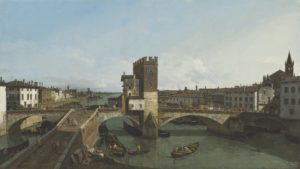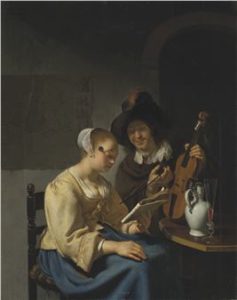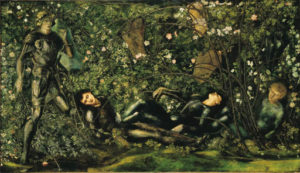On July 8th, Christie’s presented their Old Master evening sale, and this one did just a little better than their main competitor’s. My only question for the saleroom is: why did you put a Burne-Jones in this sale? Burne-Jones was born in 1833 (so he would not be classified as an Old Master artist), and he was part of the British Pre-Raphaelite movement. His paintings belong in a British Victorian or 19th-century European sale. Anyway, let us move on. (Unless otherwise noted, all prices are hammer)
The most expensive work of the evening was a large painting (52 x 92 inches) by Bernardo Bellotto titled View of Verona with the Ponte delle Navi. The work carried a hefty estimate of £12-18M and hammered down at only £9M/$12.47M (£10.6M/$14.7M with premium). It was interesting to read that the painting was last sold publicly back in 1971 and brought £300K (a pretty big number at the time, and yielded a good return on investment). Next up was Georges de la Tour’s Saint Andrew that was estimated to bring £4-6M and only achieved £3.7M/$5.1M (£4.3M/$5.9M w/p). In third was a lovely interior scene by Frans van Mieris, the Elder, titled The Music Lesson. The painting was last on the public market back in 1928 (it sold for 36,000 florins) and has been in the same family’s collection since. The painting was estimated to bring £700k-1M, and after some fierce competition, it sold for £2.9M/$4M (£3.5M/$4.8M w/p). When those little gems appear, they create a lot of action.
Rounding out the top five were Jan de Heem’s A Banquet Still Life at £2.6M/$3.6M (£3.1M/$4.3M w/p – est. £3-5M). This large work (55 x 45 inches) was one of several restituted works being offered. And then there was the outlier – Sir Edward Coley Burne-Jones’s The Prince Entering the Briar Wood. As I mentioned earlier, this really belonged in their 19th-century sale since it is NOT an Old Master work. The painting carried a £2-3M estimate and sold for £2M/$2.7M (2.4M/$3.3M w/p – it was last on the market in 2001 and sold for £1.16M/$1.6M; not a bad return).
Overall, the sale did ok, and several lots performed rather well; among them were a pair of paintings by Francesco Tironi at £420K (est. £120-180K), a Ferdinand Bol at £980K (est. £400-600K), Gentileschi’s Venus and Cupid at £2M (est. £600-1.2M), and Michaelina Wautier’s Head of a Boy at £320K (est. £60-80K). There were also a few that failed to generate any interest; these included paintings by Vivarini (est. £500-700K), Hobbema (£500-800K), and van Hemessen (£300-500K). And one expensive lot was withdrawn – van Dyck’s Portrait of Thomas Wentworth (est. £3-5M).
By the end of the session, 46 of the 60 lots found buyers (76.6%) – a much stronger sell-through rate than Sotheby’s – and the total take was £37.3M/$51.7M (£45M/$62.4M w/p). The low end of their estimate range was £40.6M, so they were a bit shy. What I did find interesting is that the first ten lots in this sale made more than Sotheby’s entire sale -- £16.7M vs. £14M.
Of the 46 sold works, 20 were below, 9 within, and 17 above their presale estimate range, leaving them with an accuracy rate of just 15%, much less than the competition; however, overall, we must give Christie’s the win.




